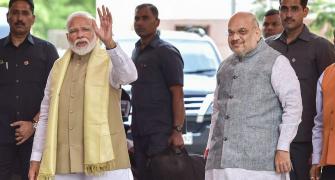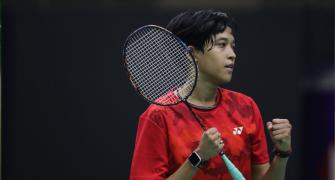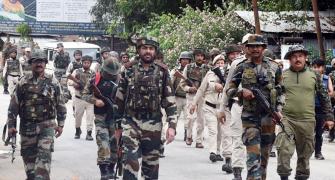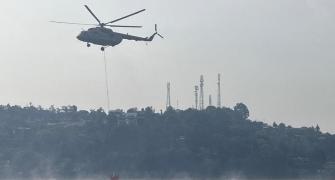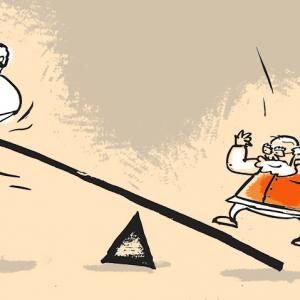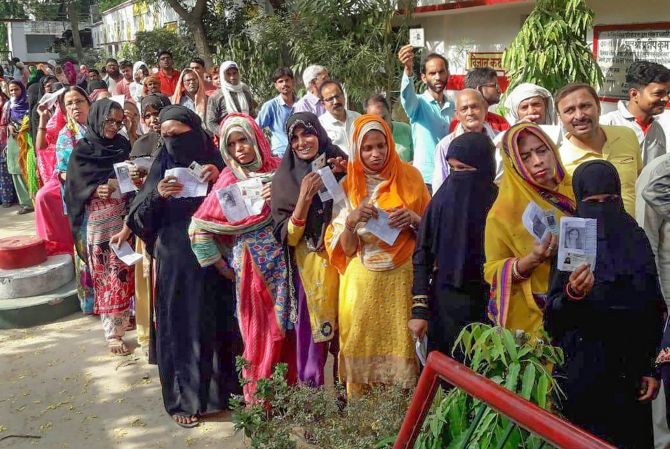An analysis of the results in Haryana reveals that caste-based voting is anything but dead.
It could even help the Bharatiya Janata Party win a second successive term in the state in the forthcoming assembly polls, reports Nitin Kumar.

Is caste politics still relevant?
Prime Minister Narendra Modi, after winning the 2019 Lok Sabha elections, said in this election people had decimated caste-based politics, which dominated the Hindi heartland.
But an analysis of the results in Haryana reveals that caste-based voting is anything but dead.
It could even help the Bharatiya Janata Party win a second successive term in the state in the forthcoming assembly polls.
The BJP has set for itself a target of abki baar 75 paar (This time it will be 75 plus seats) in the assembly elections, scheduled for October.
The evidence of the Lok Sabha polls suggests it is an ambitious but not an unrealistic target.
The BJP swept all the 10 Lok Sabha seats in Haryana.
If the results are extrapolated, the party emerged victorious in 79 of the state’s 90 assembly segments.
The Congress, the Indian National Lok Dal, and the Aam Aadmi Party-Jananayak Janata Party alliance drew a blank in the Lok Sabha.
In terms of the assembly seats won, the Congress and AAP-JJP could win only 10 and one, respectively.
Significantly, the assembly segments the BJP won are fairly populated by various castes, but those led by the opposition are either Jat or Muslim-dominated seats.
The Election Commission of India data shows the BJP trailed only in assembly segments like Garhi Sampla Kiloi, Jhajjar, Beri, Kharkhoda, Baroda, Nuh, Ferozepur Jhirka and Punahana, which are either Jat- or Muslim-dominated.
However, JJP founder Dushyant Chautala was able to take a lead over the BJP in the Jat-dominated Narnaund assembly constituency.
“It is clear that the Muslims had not voted for the BJP. And all the constituencies where the Congress took the lead are Jat-dominated. This time they had consolidated their votes and strategically voted for the Congress instead of the INLD,” said Kushal Pal, state coordinator, Lokniti, and head of the department of political science at Dyal Singh College, Karnal.
The Jats have been the dominant political class in the state despite constituting just 27 per cent of the population.
Before 2014, the state was considered the citadel of the Jats.
Of the state’s 10 chief ministers, five have been Jat and non-Jats have ruled the state for just 18 years since it was formed in 1966.
Manohar Lal Khattar, the current incumbent, became the first non-Jat chief minister of the state after 18 years in 2014.
In 1996, Bhajan Lal Bishnoi ended his term as CM.
The Congress in the past represented the non-Jat population in the state, while the INLD largely thrived on the support of the Jats.
But after 2005, Bhupinder Singh Hooda’s rise altered that political and social dynamics and made the Jats the core vote bank for the Congress.
The northern state had never witnessed communal violence.
But, the spirit of chhattis biradari, ek Haryana (36 castes, one Haryana) shattered in February 2016, when the Jats unleashed a violent agitation, demanding reservation.
The large-scale violence during the agitation, which claimed more than 30 lives, created a fertile ground for the BJP to make a rainbow coalition of 35 communities against the Jats.
“The BJP is trying to set the tune to 35 versus one for the last four years. However, this election was fought on the issue of nationalism instead of local matters. This time even the Jats had voted for the BJP,” said Yashpal Malik, president of the Akhil Bhartiya Jat Arakshan Sangharsh Samiti.
A CSDS-Lokniti post-poll survey published in The Hindu bears this out.
The BJP in the Lok Sabha polls received an overall vote share of 58 per cent in Haryana.
This comprised 74 per cent non-Jat upper castes, 73 per cent Other Backward Castes and 58 per cent SCs votes for the BJP.
While only 14 per cent of the Muslims voted for the BJP, 50 per cent Jats also voted for the party, which indicates nationalism was a key issue.
Since the February 2016 violence, the state has seen three elections -- mayoral election in 2018, Jind by-polls in January 2019, and the Lok Sabha election in May.
The BJP has swept every poll with a triumphant majority.
“The victory of the BJP is due to the Modi factor and the accentuated the chasm between the Jat and non-Jat after the 2016 violence,” said Pal.
A closer look at the numbers shows that the BJP’s sweep was mostly at the expense of the INLD, and not the Congress that much.
Overall, the BJP got 58 per cent of the votes polled and the Congress 28.44 per cent.
The INLD, which got 24 per cent of the vote share in 2014, received just about 1.89 per cent in 2019.
“The 2019 election trend clearly shows that the Jats are mostly with the Congress, and the BJP is looking towards other castes which constitute more than 70 per cent of the population,” said Pal.
Hisar MP Brijendra Singh, however, said: “The Congress getting a lead in the respective seats is because the INLD has vanished from the state and those constituencies used to be the INLD stronghold. The BJP took a lead in Hisar and Jind, where Jats are in considerable numbers. Every caste had voted for the BJP and it is a party which takes along all chhattis biradari (caste).”
The BJP is hopeful of winning a second term on the back of pro-incumbency for Khattar, his image of being an honest administrator and even-handed in treating all regions of the state, and the 35 versus one formula.
Interestingly, the new Narendra Modi government has three ministers from Haryana -- Rao Inderjit Singh, Krishan Pal Gurjar and Rattan Lal Kataria from the Yadav, Gujar and scheduled caste communities, respectively.
The BJP has two MPs -- Dharambir Singh and Brijendra Singh -- from Haryana’s Jat community.
In 2014, the BJP gave Cabinet position to the prominent Jat leader Birender Singh to appease the Jats.
“Giving a ministerial berth is the PM’s prerogative it is not based on caste. There is a process and a dedicated team to decide who will get what,” said Brijendra Singh.
The BJP is focusing on the Brahmin, Punjabi, Yadav, Gujjar, Saini, and Scheduled Caste votes to win the state polls.
“The driving force of the BJP campaign would be fulfilling the job promises to the youth on the basis of merit. The government had provided jobs to over 200,000 people till March 2018. Moreover, non-factionalism within the BJP, unlike the Congress, will help Khattar,” said Pal.



